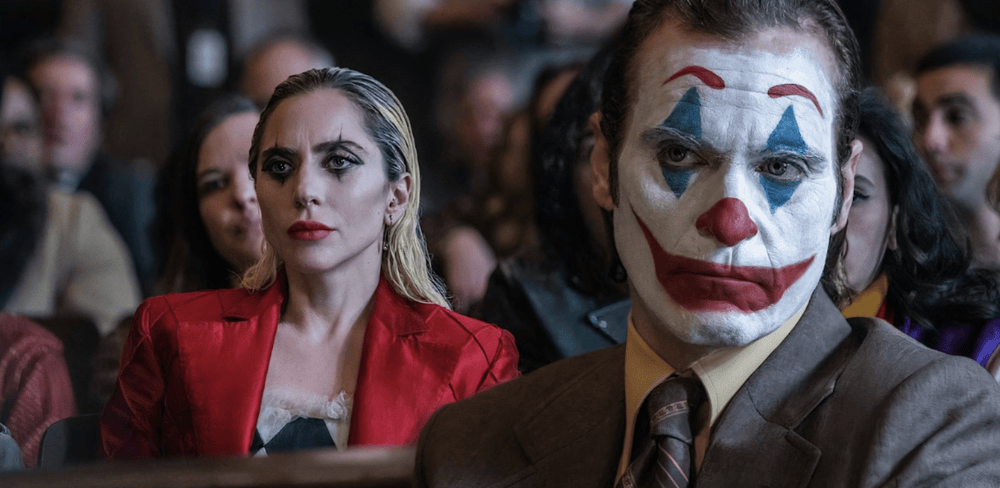Spoiler Alert! Joker: Folie à Deux Is a Joke of a Sequel
Spoiler Alert! Joker: Folie à Deux Is a Joke of a Sequel
By Thomas Harper

Scene from Joker: Folie à Deux, Warner Bros. Pictures & D.C. Films
Director Todd Phillips has released his highly anticipated film Joker: Folie à Deux, the sequel to the critically acclaimed, comic-book thriller, Joker (2019). Audiences expected Arthur Fleck (Joaquin Phoenix) to continue his maddening story through tense and violent scenes much similar to the previous film. Sadly, we received no such performance. Joker: Folie à Deux takes many messages and themes from the first film that characterized Arthur Fleck and throws them out the window.
The film starts not far from where we left the first film. Arthur is being held in Arkham Asylum, being praised by inmates and abused by asylum guards because of the six people he killed. There he meets Lee Quinzel (Lady Gaga). She admits she is an admirer of his and becomes a mentor to Arthur when it comes around to the time of his trial. Arthur’s lawyer wants to plead insanity by justifying that Arthur has dual personality disorder, that he was Joker when during the murders, not Arthur. Lee wants Arthur to commit to being Joker in order to lead a movement in Gotham representing the people left at the bottom of society because Joker is the only person who made progress in taking down privileged elites such as Murray Franklin (Robert De Niro).
The way Arthur’s thoughts and mental health is represented is very different from the manic episodes he had in the previous film. Rather than a scene where Arthur dances crookedly in runny clown makeup as he transforms himself into Joker in a rancid public restroom in Joker (2019), the film puts on a show of colorful musical numbers where Arthur and Lee are portrayed as lovers and sing songs such as Close to You and Gonna Build a Mountain. Most of these dreamlike sequences are used to convey just how much of a puppet Arthur is to Lee, but these scenes are still very much overused throughout the film. The songs drag the film a lot and are only used to switch settings a little bit because of how much time the film spends time either in the courthouse or in Arkham.
Lee’s control eventually convinces Arthur to fully commit to becoming the Joker so he fires his lawyer and chooses to represent himself against state prosecutor Harvey Dent. From here the film takes an already rough start to a downhill spiral of ill-mannered writing choices. Arthur returns to the courtroom in full Joker clown makeup and puts on a southern lawyer accent. He mockingly questions the state’s witness Gary Puddles (Leigh Gill), Arthur’s work friend who was spared in the first film, repeating questions his previous lawyer asked witnesses. After Arthur rests his facade, Gary lashes out and cries out to Arthur, pleading him to quit the Joker. He tells Arthur how scary he is and that he will certainly cause terrible things if he continues to act as Joker. Gary is the only one who is able to shake Arthur out of Joker’s ego. As Arthur delivers his closing statement he admits to everyone that he was never Joker, that Arthur chose to murder and he only represents himself. He ultimately disappoints Lee and his thousands of Gotham followers with his decision to discontinue the Joker.
As the film comes to a close and we watch as Arthur is proven guilty on all accounts of his crimes, the courthouse is bombed unexpectedly and Arthur finds himself driven through the streets of Gotham by his followers. He escapes and finds Lee, trying to tell her that they can run away. But she doesn’t love Arthur, she loves Joker. Arthur is then found by Gotham Police and brought back to Arkham to await death row. The film then ends with a random inmate stopping Arthur from meeting an unknown visitor. The inmate tells him a joke that ends with the same punchline Arthur delivered to Murray Franklin. The inmate then stabs Arthur to death, stands over his body, and cuts his face into a smile.
Joker: Folie à Deux abandons its terrifying display of violent mental illness that was portrayed in the first film and rather displays fallout and consequences of the actions a mentally ill man took in order to feel seen. The film doesn’t feel as realistic or representative of mental health issues as the previous film was. Not only does the film as a whole contain sloppy writing and interrupting musical numbers, its message subverts all that is learned from the predecessor. Joker (2019) is the story of a mentally-ill man that is tired of being ignored and unwanted, motivating him to commit heinous and violent crimes against the people that keep him down in society. It’s a critique of social hierarchy as well as a call to action to fix the system in order to prevent people ignored in society from becoming violent. The sequel has Arthur admit that he took these actions but were not guided by mental illness, and killing off the character doesn’t solve the problem that the first film was trying to bring awareness to. Joker: Folie à Deux might have been a nice concept of introducing Harley Quinn and keeping a fraction of the musical numbers wouldn’t have been that bad. The film continues excellence in cinematography, acting, and music, but Todd Phillips took into a direction that left audiences extremely disappointed and is a terrible conclusion to Arthur Fleck’s character. Honestly, Joker: Folie à Deux was a joke of a sequel.


